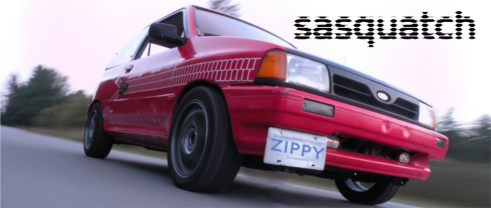Here is a simple way to re-enforce the front a-arm suspension point on Festiva's.
I used 14-ga mild steel as this is about the maximum thickness metal I can easily fabricate with hand tools.
You'll need some poster board for cutting out templates/patterns, jig saw with metal cutting blades, mini-grinder, drill motor, bunch of 3/16" drill bits, pneumatic rivet gun, 3/16" stainless pop rivets, a 6" bench vise, couple of ball peen hammers, a dead blow hammer and vice grip pliers.
Make your patterns from the poster board. Transfer shape to 14-ga steel. You can usually find 12" x 12" on E-Bay. Cut out with jig saw using a fine tooth metal cutting blade. Bend the metal approximately 90-degrees (see picture). Use the 6" vice and dead blow hammer to get the initial bend, go back over it with a regular hammer (or ball peen) to get the finished bend. It takes a series of fairly hard hits to get the metal to bend - don't plan on it bending it with only one hit!!
You can also use the vice in making making smaller bends to get a nice tight fit. Use the mini grinder to final shape the piece. Once it all fits pretty closely, mark where you want to put the rivets with a marking pen. Drill the marks out using the 3/16" drill. This is most easily done by putting the metal on some wooden 2 x 4, standing on it, and drilling away. Or use a drill press...
Take the piece back to the car and clamp it in place with the vice grips. Drill thru the car sheet metal and start installing the rivets. You'll need rivets that can be used for .060" to .188" thick metal and .188" to .250" -- depends on how many layers of sheet metal you have to go thru. The 060 to 188 will be the most common.
For further re-enforcing the frame you need a couple of pieces of 20-ga T or U shaped steel to fit and rivet on the outside of the frame. I used pieces from a bed frame that I found at the dump! These are pretty easy to make and the only close fitting is where it comes up against the sheet metal opening where the a-arm bushing fits into. I haven't done it yet, but this joint can be tack welded to further tie everything together.
Last piece is another 20-ga U shaped doubler that vertically re-enforces the sheet metal opening for the a-arm bushing. If you put this piece on, it will need to be both riveted and tack welded for best strength.
It takes about 4-hours to make and install the 90-degree doubler, about 2-hours to make and install the outside frame doubler and about an hour to make the vertical doubler. These times are PER side, so you are looking at a couple of days of work.
I used 14-ga mild steel as this is about the maximum thickness metal I can easily fabricate with hand tools.
You'll need some poster board for cutting out templates/patterns, jig saw with metal cutting blades, mini-grinder, drill motor, bunch of 3/16" drill bits, pneumatic rivet gun, 3/16" stainless pop rivets, a 6" bench vise, couple of ball peen hammers, a dead blow hammer and vice grip pliers.
Make your patterns from the poster board. Transfer shape to 14-ga steel. You can usually find 12" x 12" on E-Bay. Cut out with jig saw using a fine tooth metal cutting blade. Bend the metal approximately 90-degrees (see picture). Use the 6" vice and dead blow hammer to get the initial bend, go back over it with a regular hammer (or ball peen) to get the finished bend. It takes a series of fairly hard hits to get the metal to bend - don't plan on it bending it with only one hit!!
You can also use the vice in making making smaller bends to get a nice tight fit. Use the mini grinder to final shape the piece. Once it all fits pretty closely, mark where you want to put the rivets with a marking pen. Drill the marks out using the 3/16" drill. This is most easily done by putting the metal on some wooden 2 x 4, standing on it, and drilling away. Or use a drill press...
Take the piece back to the car and clamp it in place with the vice grips. Drill thru the car sheet metal and start installing the rivets. You'll need rivets that can be used for .060" to .188" thick metal and .188" to .250" -- depends on how many layers of sheet metal you have to go thru. The 060 to 188 will be the most common.
For further re-enforcing the frame you need a couple of pieces of 20-ga T or U shaped steel to fit and rivet on the outside of the frame. I used pieces from a bed frame that I found at the dump! These are pretty easy to make and the only close fitting is where it comes up against the sheet metal opening where the a-arm bushing fits into. I haven't done it yet, but this joint can be tack welded to further tie everything together.
Last piece is another 20-ga U shaped doubler that vertically re-enforces the sheet metal opening for the a-arm bushing. If you put this piece on, it will need to be both riveted and tack welded for best strength.
It takes about 4-hours to make and install the 90-degree doubler, about 2-hours to make and install the outside frame doubler and about an hour to make the vertical doubler. These times are PER side, so you are looking at a couple of days of work.




Comment